Our motoring reviews are in: the best supercars are yet to come
The class of 2025 are faster and certainly brasher than ever before.

With 2025 just around the corner, motoring editors Stephen Corby and Alex Inwood look to the next generation of supercars. Faster, sleeker, and certainly brasher, the likes of Bugatti and Lamborghini are ready to up their game in the year to come.
The best supercars coming in 2025
Mercedes-AMG GT 63 Pro
Just as you could – theoretically – emerge from months of gym workouts as a tauter, sexier, more confident version of yourself, so too has AMG’s flagship supercar undergone a self-improvement journey to create a leaner, meaner version.
This new model, which is badged as the Mercedes-AMG GT 63 Pro, differs from the regular grand touring-focused GT in that it’s designed primarily for owners who enjoy track days. Or, more to the point, owners who enjoy bragging to their mates that they bought the “track” version.
Naturally, there’s more power. The regular GT already has enough grunt to momentarily alter the earth’s rotation, but the twin-turbo 4.0-litre V8 in the Pro has an extra 20kW and 50Nm, boosting total outputs to 450kW and 850Nm.
Really, though, getting it done on the track is all about aerodynamics – Formula 1 cars are basically a collection of gigantic wings with a driver attached. To that end, the GT Pro’s bodywork is festooned with carbon-fibre devices and clever active aero elements that combine to boost downforce.
There are also huge titanium-backed carbon-ceramic brakes which – to ensure the Pro can pound out laps all day without being forced into the pits to cool down – are fed by larger air intakes, plus dedicated radiators for the front and rear differentials.
How much for all this engineering wizardry? Well, just as you fork out extra for PT sessions to see real results at the gym, the Pro – expected to arrive at the end of 2025 – will command a price premium above the GT, which already starts at $366,500.
Lamborghini Temerario
A brand new Lamborghini supercar is like Halley’s comet; it doesn’t come around often, but brightens the world when it does.
But someone should seriously consider giving Halley’s comet an amusing new name every 70 or so years, to make it more like a Lamborghini, because they never fail to impress. The new Temerario provides an even more seismic shock than usual.
Sadly, the brilliant 5.2-litre naturally aspirated V10 that has faithfully served the brand since 2003 (and which sounded like angels fighting) has been replaced by a smaller, electrified 4.0-litre twin-turbo V8. Happily, though, electrification elevates the Temerario to an entirely new plane of performance. The V8 delivers 588kW at a stratospheric – and no doubt deafening – 9750 RPM. However, it’s the addition of three electric motors, each with 110kW, that elevates the Temerario from supercar-fast to “better wear the brown pants today”.
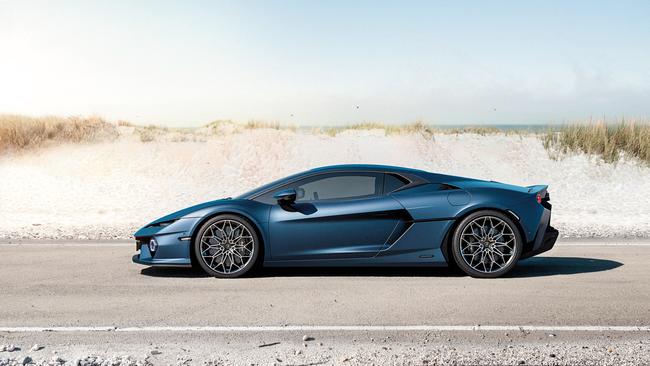
Altogether, the Temerario makes a staggering 677kW. That’s enough to hit 100km/h in 2.7 seconds on the way to a top speed of 343km/h.
Lamborghini claims there’s also a new-found focus on comfort which – like the plug-in hybrid powertrain – is a concerning declaration. A Lambo ought to look and sound unhinged, not be comfortable and (potentially) silent. Call us cautiously optimistic.
Aston Martin Valiant
If Thor was a supercar, this is what he’d look like: lantern-jawed, with rippling, muscular flanks and powered by a gigantic V12 engine. The Aston Martin Valiant is so macho that it doesn’t just scoff at most of its preening, hi-tech modern rivals, it would treat them to a proper Avenger-style beating if they so much as looked at it the wrong way in a bar. This is a bruiser of a car.
Central to Valiant’s testosterone-gurgling charm is what you’ll find in the middle of its centre console – a proper manual gear shift. Power comes from the fire-breathing 5.2-litre twin-turbo V12 producing 555kW and 753Nm, all sent solely to the rear wheels through that bespoke six-speed manual gearbox. It sounds so over the top you’ll probably need two feet just to operate the clutch.

So who is the Valiant for? Technically speaking, it’s the company car of Aston Martin Formula 1 driver Fernando Alonso – who looked at the new limited-edition Valour supercar, itself a tribute to an Aston Le Mans racing car from the late 1970s, and thought, “Looks good, but could it be angrier?”.
The Spanish racing star asked for extra aerodynamics, racier motorsport suspension and, of course, more power. The result is this carbon fibre-bodied supercar that Aston Martin liked so much, it decided to build a staggering 38 of them – all of which are now sold, despite costing $3 million apiece.
Audi RS e-tron GT Performance
Until the moment you actually try it, the idea of a fullbore acceleration run in a hyper-powerful EV sounds like a lot of fun. Trust me, it’s not, unless perniciously painful roller-coasters are your thing. Unlike petrol cars, which give your insides a tiny respite from the ferocious forces of thrust when they change gears, an explosively launched performance EV relentlessly pummels your internal organs.
That would suggest that even more power is not what high-performance EVs are crying out for. Audi clearly begs to differ, however. For 2025 it’s giving the Audi e-tron GT – the German marque’s flagship EV – an update, bringing an almost ungodly power increase to a maximum of 680kW in slingshot-like launch-control mode.
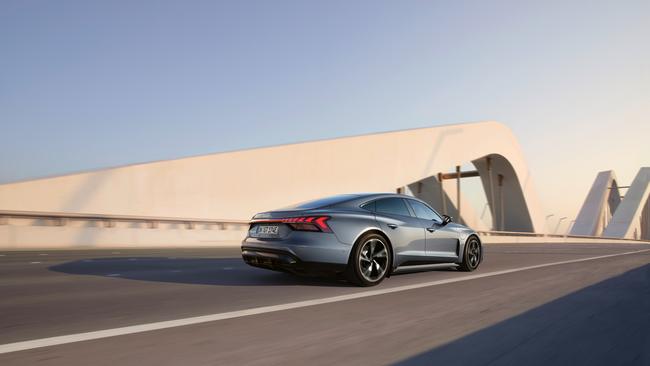
This makes the GT Performance model the most powerful production Audi ever built, and cuts the 0 to 100km/h sprint to a kidney-bursting 2.5 seconds. Part of their mad magic is a new battery that’s bigger yet lighter. The regenerative braking is more ferocious, too, and the rear electric motor is also lighter by 10kg, although that’s like praising an elephant for shedding a few pounds, since the e-tron GT is still colossally heavy for a performance car at 2.3 tonnes.
Pricing is yet to be confirmed by Audi, and we will need to wait until we drive the GT Performance upon its release early next year to see what all this extra potency does to one’s insides.
Ferrari 12Cilindri
Unlike Lamborghini, which has a terrific track record of naming cars after famous and exotic-sounding bulls such as the Diablo and Aventador, Ferrari’s form when it comes to deciding what to call new models is patchy.
Mostly, it gets it right – Enzo, Testarossa and Daytona are great examples. Other times it can be a tad … literal. One example is the 812 Superfast, which, while inarguably accurate, seemed a little obvious. Then there’s the Ferrari LaFerrari. Yep, Ferrari The Ferrari.
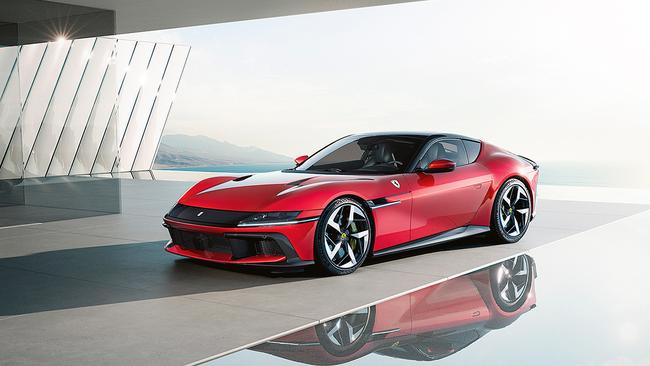
Now we have the Ferrari 12Cilindri, which translates as Ferrari 12 Cylinder. Like many things in life, it does sound sexier when you say it in Italian – Dodici Cilindri.
It’s also a not-subtle hint as to what this car is all about – an enormous engine which displaces a whopping 6.5 litres and is nestled beneath a gigantic, front-hinged bonnet. The V12 produces 610kW and 678Nm, and that’s without the assistance of turbos or any electrification. So there’ll be no turbo lag and this new front-engined flagship should sound truly primal at its 9500 RPM redline.
An even more attractive Spider version – or convertible – also exists, to further treat your ears to that operatic V12.
Both versions receive the full gamut of Ferrari’s hi-tech chassis systems, so are almost guaranteed to be great to drive. Provided of course you’re willing to fork over the princely sum of $803,500. Maybe the price tag will sound better in Italian, too?
Bugatti Tourbillon
When Bugatti appointed EV pioneer Mate Rimac as its new chief executive, there were genuine fears the W16-powered Bugatti Chiron hypercar’s replacement would be fully electric. After all, the brilliantly named Mate (he’d be a hit at Aussie events) had built his entire career on producing EV hypercars for his own company, Rimac, so fast and capable as to embarrass competitors from Ferrari, Lamborghini and Pagani.
While Rimac reportedly contemplated batteries and a plug for the new Bugatti, he eventually did almost the complete opposite, developing an entirely new (and surprisingly old-school) 8.3-litre naturally aspirated V16 engine that makes 735kW.
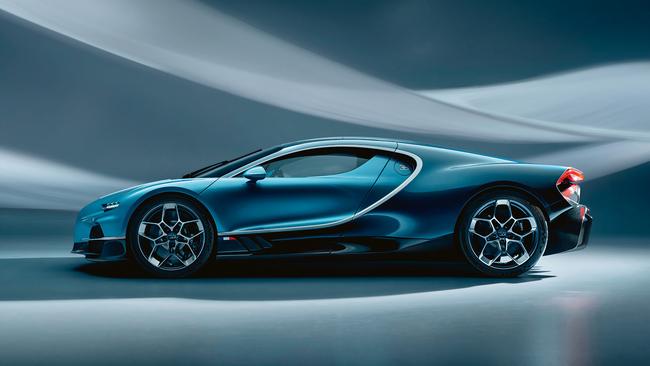
“Our customers like the emotion of an internal-combustion engine, and I have to build cars our customers want to buy,” says old Mate, as we’ll call him.
This masterpiece of an engine is built by Cosworth and paired by Bugatti with three electric motors that make an additional 588kW, giving the Tourbillon a scarcely believable combined total output of 1342kW. That’s more than two times the output of a McLaren 750S, which is one of the most savage supercars we’ve ever driven.
Zero to 100km/h is said to take two seconds flat, 200km/h comes up in less than five, and before the stopwatch hits double digits, you’re sailing past 300km/h. Top speed is 445km/h, at which point you’ll be covering 123 metres every second.
Just as compelling is that the Tourbillon doesn’t even have to be moving to be considered automotive art. The cabin is a sumptuous mix of billet aluminium, carbon fibre and crystal. But the truly jaw-dropping part is the fully mechanical instrument cluster, designed to look like a skeletonised Swiss watch. The dials comprise more than 600 tiny titanium parts, with the smallest measuring just five microns.
The price is anything but tiny, starting at €3.8 million ($6.2 million).
Porsche 911 GTS T-Hybrid
It might look like every other 911 from the past 60 years, but this could just be the most controversial Porsche in, well, possibly ever. That’s because underneath the familiar bodywork lurks an all-new powertrain shot through with electricity. In a move sure to make diehard fans groan and keyboard warriors crack their knuckles, the legendary Porsche 911 has gone hybrid.
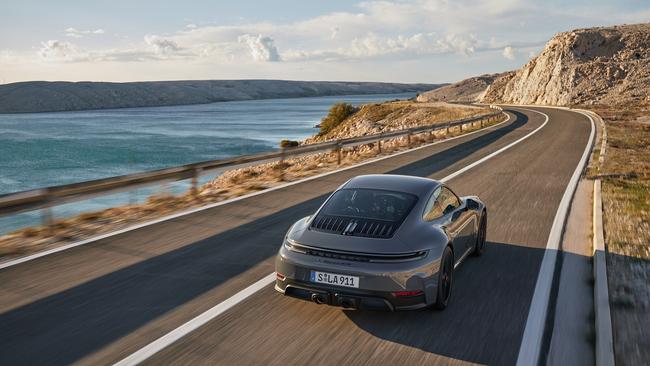
The new engine, which Porsche calls T-Hybrid, has been in public development for two years, but that’s done little to dilute the controversy of messing with the 911’s beloved flat-six powertrain. Aficionados lose their minds when the factory changes so much as the dust caps on the wheels. How on earth will they respond to this?
Porsche is acutely aware of this trepidation, and thus wisely chose a hybrid system that retains a flat-six petrol engine at its heart. The all-new 3.6-litre petrol engine is fitted with a hi-tech electric turbo and is still mounted in the traditional spot behind the rear axle. It is only fitted to the GTS model grade (for now).
Unlike most turbos, which rely on slow-moving exhaust gases to build boost, this new e-turbo wedges a tiny electric motor between the turbine and compressor wheels, which Porsche says will completely eradicate lag. Another highly significant electrical addition is the inclusion of an e-motor within the 911’s dual-clutch gearbox, which is fed by a small and incredibly hi-tech 1.9kWh battery.
All up, the Porsche GTS T-Hybrid makes 353kW and 570Nm, which is 40kW/50Nm more than an equivalent, non-hybrid 911 GTS, and can rocket to 100km/h in a supercar-like 3.0 seconds.
Supercar performance from the middle-of-the-road 911? Maybe hybridisation isn’t such a scandal after all.
Pagani Utopia Roadster
Horacio Pagani always aims to build cars that seamlessly blend engineering with art, but few have succeeded quite so magnificently as the Utopia Roadster.
I mean, just look at it, dressed here in exposed Habanero Red carbon fibre bodywork. It’s so impossibly attractive that you’d be forgiven for wanting to mount it on a glass plinth instead of driving it.
That would be a shame, however, because the Utopia’s on-paper performance credentials are even more appealing than its looks. In an age when performance cars are getting heavier (the new BMW M5 weighs a staggering 2.4 tonnes), the Utopia Roadster hits the scales at a bantamweight 1280 kilograms.
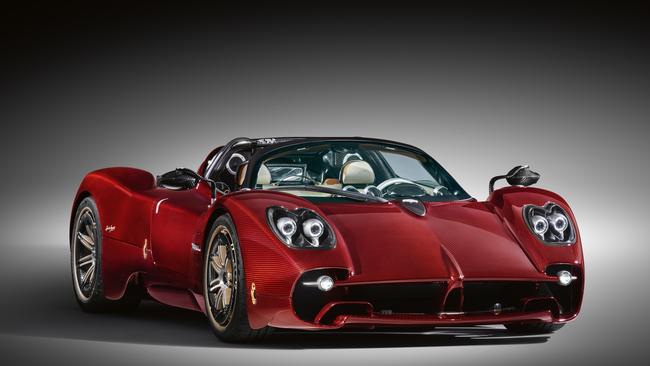
Power comes from a Mercedes-AMG-sourced twin-turbo 6.0-litre V12 with 635kW. Amazingly, you can choose to shift gears yourself via a seven-speed manual gearbox with jewel-like, exposed linkages. It all sounds too good to be true, and we haven’t even mentioned the rest of the cabin yet, which is an exquisite collection of handcrafted analog dials and sports seats made from carbo-titanium.
Even the tyres are hi-tech. These “cyber tyres” have been specially developed by Pirelli to communicate with the car’s traction-control systems.
Really, though, all this cutting-edge wizardry is secondary. What this limited-edition, $5.2 million car is truly about is removing its roof (there’s also a hardtop version) to better revel in the hair-raising acoustics of that glorious V12. And marvelling at your reflection in shop windows.





To join the conversation, please log in. Don't have an account? Register
Join the conversation, you are commenting as Logout